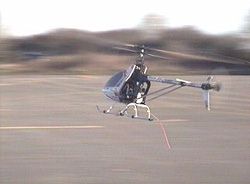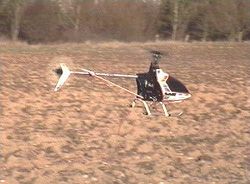

| Part 3 - Autorotations |
By
Jeff Barrington - Newton Abbot Heli Club
 There
are many pilots who advance to quite a high level of flying yet never
bother to learn autorotations (autos), a comment often heard is "why stop
an engine that is going perfectly well", fair comment I suppose but what
if your engine cuts, chances are you will panic and crash the model. So
there is one good reason to learn autos, the other reason being the shear
satisfaction of landing your model time after time with no engine power.
I having gone through many stages of learning to fly but I found the autorotation
the most rewarding of all.
There
are many pilots who advance to quite a high level of flying yet never
bother to learn autorotations (autos), a comment often heard is "why stop
an engine that is going perfectly well", fair comment I suppose but what
if your engine cuts, chances are you will panic and crash the model. So
there is one good reason to learn autos, the other reason being the shear
satisfaction of landing your model time after time with no engine power.
I having gone through many stages of learning to fly but I found the autorotation
the most rewarding of all.
During autorotation the negative pitch will control the glide angle of decent, this will be about minus 3 degrees but will vary according to wind conditions, blades, and forward speed during the auto. I always set my negative pitch to about minus 5 degrees and then adjust the pitch with the stick to get the ideal decent angle.
 Before
you start, you will need to set your throttle hold switch so that it gives
a reliable engine tick over when operated. If your tail is driven during
autos you should set the tail blades with no pitch when the hold switch
is operated, as there is no torque from the rotor head during autorotation
the tail does not need any counter acting pitch. You must be able to perform
a 45 degree approach and landing before any attempt at autos. Also make
sure you are familiar with the throttle hold switch position on the transmitter,
you will need to find it quickly while practising.
Before
you start, you will need to set your throttle hold switch so that it gives
a reliable engine tick over when operated. If your tail is driven during
autos you should set the tail blades with no pitch when the hold switch
is operated, as there is no torque from the rotor head during autorotation
the tail does not need any counter acting pitch. You must be able to perform
a 45 degree approach and landing before any attempt at autos. Also make
sure you are familiar with the throttle hold switch position on the transmitter,
you will need to find it quickly while practising.
To give you an idea of how much power is in the rotor head with no engine power, from the ground, raise the throttle until the model is light on the skids, switch to throttle hold and gently add pitch, the model will hover for a short time.
 Start
by flying your normal circuits at a safe height, when flying into wind
hit the hold switch and apply negative pitch, the forward motion of the
model should keep the tail straight, if the tail kicks to the left or
right return the hold switch to normal and land the model, adjust the
tail trim and try again. Once you are happy with the tail trim keep practising
autorotation descents but only down to a height that will give you time
to abort (return the hold switch to normal). After hours of practise you
will be able to descend at 45 degrees, apply back cyclic to flair (stop
the forward speed) and add pitch to land. The difficult part is the timing
of all this, if you add to much pitch to early (to high) you will use
up the inertia in the rotor head and will not have enough to land. If
you add pitch to late the result is obvious.
Start
by flying your normal circuits at a safe height, when flying into wind
hit the hold switch and apply negative pitch, the forward motion of the
model should keep the tail straight, if the tail kicks to the left or
right return the hold switch to normal and land the model, adjust the
tail trim and try again. Once you are happy with the tail trim keep practising
autorotation descents but only down to a height that will give you time
to abort (return the hold switch to normal). After hours of practise you
will be able to descend at 45 degrees, apply back cyclic to flair (stop
the forward speed) and add pitch to land. The difficult part is the timing
of all this, if you add to much pitch to early (to high) you will use
up the inertia in the rotor head and will not have enough to land. If
you add pitch to late the result is obvious.
Autorotations are easier with a 60 size model due to the extra blade power but wither it's a 60 or 30 size model, the type and weight of the blades will have a major effect on auto performance, use glass/carbon blades like SAB or TG for best performance.
Part 4 will be on setting up your helicopter for aerobatics!
Keep practising but remember - it supposed to be fun!
This page has been contributed by Jeff
Barrington
Web Site:
Newton Abbot Heli Club